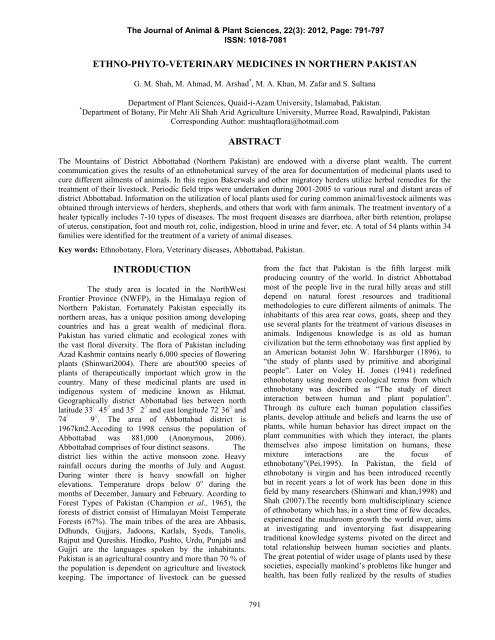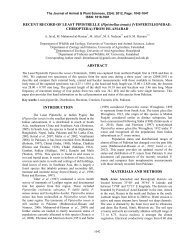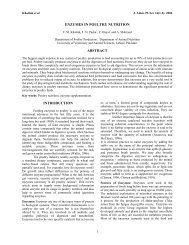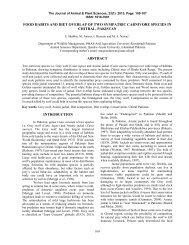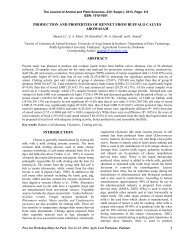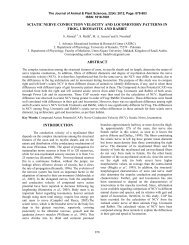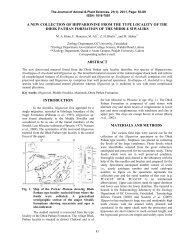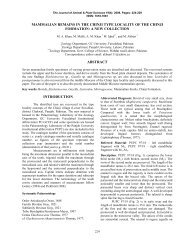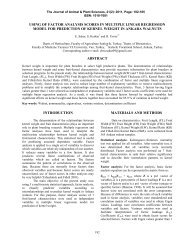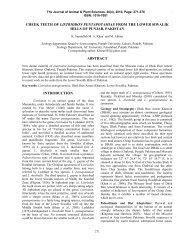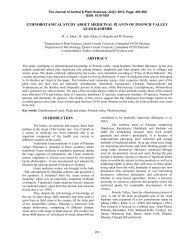ethno-phyto-veterinary medicines in northern pakistan - Journal of ...
ethno-phyto-veterinary medicines in northern pakistan - Journal of ...
ethno-phyto-veterinary medicines in northern pakistan - Journal of ...
Create successful ePaper yourself
Turn your PDF publications into a flip-book with our unique Google optimized e-Paper software.
Shah et al.,<br />
The <strong>Journal</strong> <strong>of</strong> Animal & Plant Sciences, 22(3): 2012, Page:<br />
J.<br />
791-797<br />
Anim. Plant Sci. 22(3):2012<br />
ISSN: 1018-7081<br />
ETHNO-PHYTO-VETERINARY MEDICINES IN NORTHERN PAKISTAN<br />
G. M. Shah, M. Ahmad, M. Arshad * , M. A. Khan, M. Zafar and S. Sultana<br />
Department <strong>of</strong> Plant Sciences, Quaid-i-Azam University, Islamabad, Pakistan.<br />
* Department <strong>of</strong> Botany, Pir Mehr Ali Shah Arid Agriculture University, Murree Road, Rawalp<strong>in</strong>di, Pakistan<br />
Correspond<strong>in</strong>g Author: mushtaqflora@hotmail.com<br />
ABSTRACT<br />
The Mounta<strong>in</strong>s <strong>of</strong> District Abbottabad (Northern Pakistan) are endowed with a diverse plant wealth. The current<br />
communication gives the results <strong>of</strong> an <strong>ethno</strong>botanical survey <strong>of</strong> the area for documentation <strong>of</strong> medic<strong>in</strong>al plants used to<br />
cure different ailments <strong>of</strong> animals. In this region Bakerwals and other migratory herders utilize herbal remedies for the<br />
treatment <strong>of</strong> their livestock. Periodic field trips were undertaken dur<strong>in</strong>g 2001-2005 to various rural and distant areas <strong>of</strong><br />
district Abbottabad. Information on the utilization <strong>of</strong> local plants used for cur<strong>in</strong>g common animal/livestock ailments was<br />
obta<strong>in</strong>ed through <strong>in</strong>terviews <strong>of</strong> herders, shepherds, and others that work with farm animals. The treatment <strong>in</strong>ventory <strong>of</strong> a<br />
healer typically <strong>in</strong>cludes 7-10 types <strong>of</strong> diseases. The most frequent diseases are diarrhoea, after birth retention, prolapse<br />
<strong>of</strong> uterus, constipation, foot and mouth rot, colic, <strong>in</strong>digestion, blood <strong>in</strong> ur<strong>in</strong>e and fever, etc. A total <strong>of</strong> 54 plants with<strong>in</strong> 34<br />
families were identified for the treatment <strong>of</strong> a variety <strong>of</strong> animal diseases.<br />
Key words: Ethnobotany, Flora, Veter<strong>in</strong>ary diseases, Abbottabad, Pakistan.<br />
INTRODUCTION<br />
The study area is located <strong>in</strong> the NorthWest<br />
Frontier Prov<strong>in</strong>ce (NWFP), <strong>in</strong> the Himalaya region <strong>of</strong><br />
Northern Pakistan. Fortunately Pakistan especially its<br />
<strong>northern</strong> areas, has a unique position among develop<strong>in</strong>g<br />
countries and has a great wealth <strong>of</strong> medic<strong>in</strong>al flora.<br />
Pakistan has varied climatic and ecological zones with<br />
the vast floral diversity. The flora <strong>of</strong> Pakistan <strong>in</strong>clud<strong>in</strong>g<br />
Azad Kashmir conta<strong>in</strong>s nearly 6,000 species <strong>of</strong> flower<strong>in</strong>g<br />
plants (Sh<strong>in</strong>wari2004). There are about500 species <strong>of</strong><br />
plants <strong>of</strong> therapeutically important which grow <strong>in</strong> the<br />
country. Many <strong>of</strong> these medic<strong>in</strong>al plants are used <strong>in</strong><br />
<strong>in</strong>digenous system <strong>of</strong> medic<strong>in</strong>e known as Hikmat.<br />
Geographically district Abbottabad lies between north<br />
latitude 33 / 45 // and 35 / 2 // and east longitude 72 / 36 // and<br />
74 /<br />
9 // . The area <strong>of</strong> Abbottabad district is<br />
1967km2.Accod<strong>in</strong>g to 1998 census the population <strong>of</strong><br />
Abbottabad was 881,000 (Anonymous, 2006).<br />
Abbottabad comprises <strong>of</strong> four dist<strong>in</strong>ct seasons. The<br />
district lies with<strong>in</strong> the active monsoon zone. Heavy<br />
ra<strong>in</strong>fall occurs dur<strong>in</strong>g the months <strong>of</strong> July and August.<br />
Dur<strong>in</strong>g w<strong>in</strong>ter there is heavy snowfall on higher<br />
elevations. Temperature drops below 0 o dur<strong>in</strong>g the<br />
months <strong>of</strong> December, January and February. Acord<strong>in</strong>g to<br />
Forest Types <strong>of</strong> Pakistan (Champion et al., 1965), the<br />
forests <strong>of</strong> district consist <strong>of</strong> Himalayan Moist Temperate<br />
Forests (67%). The ma<strong>in</strong> tribes <strong>of</strong> the area are Abbasis,<br />
Ddhunds, Gujjars, Jadoons, Karlals, Syeds, Tanolis,<br />
Rajput and Qureshis. H<strong>in</strong>dko, Pushto, Urdu, Punjabi and<br />
Gujjri are the languages spoken by the <strong>in</strong>habitants.<br />
Pakistan is an agricultural country and more than 70 % <strong>of</strong><br />
the population is dependent on agriculture and livestock<br />
keep<strong>in</strong>g. The importance <strong>of</strong> livestock can be guessed<br />
791<br />
from the fact that Pakistan is the fifth largest milk<br />
produc<strong>in</strong>g country <strong>of</strong> the world. In district Abbottabad<br />
most <strong>of</strong> the people live <strong>in</strong> the rural hilly areas and still<br />
depend on natural forest resources and traditional<br />
methodologies to cure different ailments <strong>of</strong> animals. The<br />
<strong>in</strong>habitants <strong>of</strong> this area rear cows, goats, sheep and they<br />
use several plants for the treatment <strong>of</strong> various diseases <strong>in</strong><br />
animals. Indigenous knowledge is as old as human<br />
civilization but the term <strong>ethno</strong>botany was first applied by<br />
an American botanist John W. Harshburger (1896), to<br />
“the study <strong>of</strong> plants used by primitive and aborig<strong>in</strong>al<br />
people”. Later on Voley H. Jones (1941) redef<strong>in</strong>ed<br />
<strong>ethno</strong>botany us<strong>in</strong>g modern ecological terms from which<br />
<strong>ethno</strong>botany was described as “The study <strong>of</strong> direct<br />
<strong>in</strong>teraction between human and plant population”.<br />
Through its culture each human population classifies<br />
plants, develop attitude and beliefs and learns the use <strong>of</strong><br />
plants, while human behavior has direct impact on the<br />
plant communities with which they <strong>in</strong>teract, the plants<br />
themselves also impose limitation on humans, these<br />
mixture <strong>in</strong>teractions are the focus <strong>of</strong><br />
<strong>ethno</strong>botany”(Pei,1995). In Pakistan, the field <strong>of</strong><br />
<strong>ethno</strong>botany is virg<strong>in</strong> and has been <strong>in</strong>troduced recently<br />
but <strong>in</strong> recent years a lot <strong>of</strong> work has been done <strong>in</strong> this<br />
field by many researchers (Sh<strong>in</strong>wari and khan,1998) and<br />
Shah (2007).The recently born multidiscipl<strong>in</strong>ary science<br />
<strong>of</strong> <strong>ethno</strong>botany which has, <strong>in</strong> a short time <strong>of</strong> few decades,<br />
experienced the mushroom growth the world over, aims<br />
at <strong>in</strong>vestigat<strong>in</strong>g and <strong>in</strong>ventory<strong>in</strong>g fast disappear<strong>in</strong>g<br />
traditional knowledge systems pivoted on the direct and<br />
total relationship between human societies and plants.<br />
The great potential <strong>of</strong> wider usage <strong>of</strong> plants used by these<br />
societies, especially mank<strong>in</strong>d’s problems like hunger and<br />
health, has been fully realized by the results <strong>of</strong> studies
Shah et al., J. Anim. Plant Sci. 22(3):2012<br />
carried out so far. Peoples traditional knowledge (TK)<br />
perta<strong>in</strong><strong>in</strong>g to animal health care and production is known<br />
as <strong>ethno</strong>-<strong>veter<strong>in</strong>ary</strong> medic<strong>in</strong>e (EVM) McCorkle<br />
(1992).Ethno<strong>veter<strong>in</strong>ary</strong> <strong>medic<strong>in</strong>es</strong> (EVM) are as old as<br />
the domestication <strong>of</strong> various livestock animal species.<br />
Despite the advancement <strong>of</strong> pharmaceutical <strong>in</strong>dustry and<br />
development <strong>of</strong> cl<strong>in</strong>ical agents, traditional <strong>in</strong>digenous<br />
medic<strong>in</strong>e is still practiced <strong>in</strong> rural areas for human and<br />
livestock ailments. These <strong>ethno</strong>-<strong>veter<strong>in</strong>ary</strong> <strong>medic<strong>in</strong>es</strong> and<br />
practices are holistic livestock health care and<br />
management methodologies adopted <strong>in</strong> various parts <strong>of</strong><br />
the world. Recognoniz<strong>in</strong>g the importance <strong>of</strong> such<br />
traditional <strong>medic<strong>in</strong>es</strong> for livestock Food and Agriculture<br />
Organization (FAO) Regional Office for Asia and the<br />
Pacific has pr<strong>in</strong>ted a series <strong>of</strong> publication on the<br />
development and promotion <strong>of</strong> traditional <strong>veter<strong>in</strong>ary</strong><br />
<strong>medic<strong>in</strong>es</strong> dur<strong>in</strong>g the past few years (FAO, 1984, 1991<br />
and 1992). Dur<strong>in</strong>g recent years, there has been wide<br />
concern for collect<strong>in</strong>g more <strong>ethno</strong>botanical <strong>in</strong>formation,<br />
especially <strong>ethno</strong>medic<strong>in</strong>al <strong>in</strong>formation on plants (Alemu,<br />
1993). In India and other countries good attempts have<br />
been made by Pal (1980), McCorkle (1994), Pande and<br />
Kumar (1994), Catley and Mohammad (1996), Goud and<br />
Pullaiah (1996) and Kohler-Rollefson and Rathore (1997)<br />
to document the medic<strong>in</strong>al plants used to cure animal<br />
diseases, but <strong>in</strong> Pakistan very little attention has been<br />
given on documentation <strong>of</strong> plants used as <strong>veter<strong>in</strong>ary</strong><br />
<strong>medic<strong>in</strong>es</strong> and there is a dire need to document this<br />
knowledge. At present the valuable traditional<br />
knowledge is disappear<strong>in</strong>g rapidly. Moreover the<br />
escalat<strong>in</strong>g cost <strong>of</strong> allopathic <strong>medic<strong>in</strong>es</strong> and the problem<br />
<strong>of</strong> environmental pollution, this is the time to develop<br />
cost-effective and environment friendly <strong>medic<strong>in</strong>es</strong> for<br />
animal diseases. In the study area this is the first attempt<br />
to elucidate the <strong>ethno</strong>medic<strong>in</strong>al uses <strong>of</strong> plants as<br />
<strong>veter<strong>in</strong>ary</strong> <strong>medic<strong>in</strong>es</strong>. Local health traditions that rely on<br />
medic<strong>in</strong>al plants tend to be oral and thus largely<br />
undocumented and are at risk <strong>of</strong> disappear<strong>in</strong>g. Therefore<br />
the endeavour before us is to revive the traditional<br />
technologies <strong>of</strong> livestock health care management by<br />
updat<strong>in</strong>g documents and validate the practices for the use<br />
<strong>of</strong> farmers and veter<strong>in</strong>arians. Qureshi et al., (2008) and<br />
Abbasi et al., (2010) conducted surveys <strong>of</strong> useful<br />
medic<strong>in</strong>al plants <strong>in</strong> mounta<strong>in</strong> region <strong>of</strong> Abbottabad<br />
Northern Pakistan. They documented plants used to cure<br />
human ailments but no <strong>in</strong>formation is available on<br />
<strong>ethno</strong>vetr<strong>in</strong>ary plants. The district rema<strong>in</strong>s largely<br />
unexplored <strong>in</strong> this aspect <strong>of</strong> <strong>ethno</strong>botany. This study was<br />
undertaken to document the use <strong>of</strong> local plants <strong>of</strong> district<br />
Abbottabad <strong>in</strong> the treatment <strong>of</strong> different animal diseases<br />
and it will be an addition to the <strong>ethno</strong>botany and a base<br />
for future research.<br />
792<br />
MATERIALS AND METHODS<br />
The present study is based on extensive surveys.<br />
Periodic field trips were undertaken dur<strong>in</strong>g 2001-2005 to<br />
various rural and distant areas <strong>of</strong> district Abbottabad<br />
<strong>in</strong>clud<strong>in</strong>g Nathia Gali, Sherwan, Kuthiala, Richh Behn,<br />
Havelian and Thandiani on the utilization <strong>of</strong> local plants<br />
used for cur<strong>in</strong>g common animal/livestock ailments. Local<br />
name <strong>of</strong> the plants and their uses to cure various animal<br />
diseases were documented by conduct<strong>in</strong>g <strong>in</strong>terviews. The<br />
<strong>in</strong>terviews were carried out <strong>in</strong> local community, to<br />
<strong>in</strong>vestigate local people and knowledgeable persons<br />
(Hakims, Women and Herdsmen) who are the ma<strong>in</strong> user<br />
<strong>of</strong> medic<strong>in</strong>al plants. About 200 <strong>in</strong>formants have been<br />
<strong>in</strong>terviewed on random basis. The respective voucher<br />
specimens and crude samples <strong>of</strong> each preparation were<br />
collected from different areas for their correct<br />
identification through the available literature (Hooker,<br />
1872-1897and Stewart et al.(1972) and Nasir and Ali,<br />
(1971-1995). The voucher specimens were deposited <strong>in</strong><br />
the Herbarium, Department <strong>of</strong> Botany, Govt. Post<br />
Graduate College, Abbottabad, as reference specimens<br />
for future work. Repeated queries were made for the<br />
same plant and same uses from different people at<br />
different places, <strong>in</strong> order to verify the accuracy <strong>of</strong><br />
<strong>in</strong>formation.<br />
RESULTS<br />
A total <strong>of</strong> 54 plants <strong>in</strong> 34 families are used as<br />
<strong>medic<strong>in</strong>es</strong> <strong>in</strong> <strong>veter<strong>in</strong>ary</strong> practice by local farmers,<br />
herders, shepherds <strong>in</strong> the hilly areas <strong>of</strong> district<br />
Abbottabad.<br />
Information on plants used as the traditional<br />
<strong>veter<strong>in</strong>ary</strong> <strong>medic<strong>in</strong>es</strong> <strong>in</strong> the District Abbottabad.<br />
1. Aconitum violaceum Jack. ex Stapf.<br />
Family-Ranunculaceae<br />
Ln: Patris; Loc: Thandiani; Pu: Rhizome<br />
Ethno-Veter<strong>in</strong>ary uses: The rhizome is gr<strong>in</strong>ded and<br />
mixed with wheat flour .It is given to cattle for the<br />
treatment <strong>of</strong> lungs diseases<br />
VN: GMS-001<br />
2. Adhatoda vasica Nees.<br />
Family-Acanthaceae<br />
Ln: Bhaikar; Loc: Sherwan; Pu: Leaves; Habit: Shrub<br />
Ethno-Veter<strong>in</strong>ary uses: A poultice <strong>of</strong> leaves is used for<br />
fresh wounds heal<strong>in</strong>g and <strong>in</strong>flammatory swell<strong>in</strong>gs<br />
VN: GMS-002<br />
3. Aesculus <strong>in</strong>dica (Wall. Ex Camb.) Hk.f.<br />
Family-Hippocastanaceae<br />
Ln: Bankhor; L oc: Nathia Galli; Pu: Seeds; Habit: Tree<br />
Ethno-Veter<strong>in</strong>ary uses: Seeds are gr<strong>in</strong>ded to<br />
powder form, mixed with maize flour and tablets are<br />
formed. One tablet is given daily to goats and hoarses <strong>in</strong><br />
stomach troubles and colic.
Shah et al., J. Anim. Plant Sci. 22(3):2012<br />
VN: GMS-003<br />
4. Ailanthus altissima (Mill.) Sw<strong>in</strong>gle.<br />
Family-Simarubaceae<br />
Ln: Darawa; L oc: Sherwan; Pu: Leaves Habit: Tree<br />
Ethno-Veter<strong>in</strong>ary uses: Leaves are used as fodder to br<strong>in</strong>g<br />
the cattle <strong>in</strong>to heat but milk<strong>in</strong>g cattles are not given. Also<br />
used as purgative.<br />
VN: GMS-004<br />
5. Allium sepa L<strong>in</strong>n.<br />
Family-Liliaceae<br />
Ln: Piaz; L oc: Sherwan; Pu: Tubers and seeds; Habit:<br />
Herb<br />
Ethno-Veter<strong>in</strong>ary uses: Seeds are given to hens<br />
<strong>in</strong> case <strong>of</strong> Rani Khait disease. Crushed bulbs are given to<br />
cattle to remove external parasites and maggots from<br />
wounds and given to buffaloes <strong>in</strong> fever.<br />
VN: GMS-005<br />
6. Amranthus viridis L<strong>in</strong>n.<br />
Family-Amaranthaceae<br />
Ln: Chalvera; Loc: Sherwan; Pu: Whole plant; Habit:<br />
Herb<br />
Ethno-Veter<strong>in</strong>ary uses: Fresh plants are given to cattle as<br />
purgative <strong>in</strong> case <strong>of</strong> constipation.<br />
VN: GMS-006<br />
7. Arisaema flavum (Forsska.)Schott<br />
Family-Araceae<br />
Ln: Soorganda; Loc: Nathiagali; Pu: Seeds; Habit: Herb<br />
Ethno-Veter<strong>in</strong>ary uses: Seeds are given to poultry aga<strong>in</strong>st<br />
“Rani Khait” disease.<br />
VN: GMS-007<br />
8. Artemisia maritima L<strong>in</strong>n.<br />
Family-Asteraceae<br />
Ln: Chaow; L oc: Sherwan; Pu: Whole plant; Habit:<br />
Herb<br />
Ethno-Veter<strong>in</strong>ary uses: The flower<strong>in</strong>g heads and young<br />
branches are given for expell<strong>in</strong>g round worms.<br />
VN: GMS-008<br />
9. Artemisia vulgaris L<strong>in</strong>n.<br />
Family-Asteraceae<br />
Ln: Chaow; L oc: Sherwan; Pu: Whole plant; Habit:<br />
Herb<br />
Ethno-Veter<strong>in</strong>ary uses: The whole plant is dried<br />
and crushed <strong>in</strong>to powder form and given to horses <strong>in</strong><br />
colic. Dried leaves are given as anthelm<strong>in</strong>tic.<br />
VN: GMS-009<br />
10. Berberis lycium Royle.<br />
Family-Berberidaceae<br />
Ln: Sumbal; Loc: Sherwan/Thandiani; Pu: Root barks;<br />
Habit: Shrub<br />
Ethno-Veter<strong>in</strong>ary uses: Dried root bark is mixed<br />
with Ghee and heated. This is used as bandage on the<br />
broken organs. Powdered root bark is used as antiseptic<br />
and for heal<strong>in</strong>g <strong>of</strong> wounds. It is also given for <strong>in</strong>ternal<br />
<strong>in</strong>jury.<br />
VN: GMS-0010<br />
793<br />
11. Bergenia ciliata (Haw.) Sternb.<br />
Family-Saxifragaceae<br />
Ln: Butpewa; Loc: Nathia Galli; Pu: Rhizome; Habit:<br />
Herb<br />
Ethno-Veter<strong>in</strong>ary uses: Powdered rhizome is<br />
mixed with gur (Raw sugar) and wheat flour. Tablets are<br />
made and given <strong>in</strong> case <strong>of</strong> <strong>in</strong>ternal <strong>in</strong>jury .Powder <strong>of</strong><br />
rhizome is used as antiseptic on wounds.<br />
VN: GMS-0011<br />
12. Brassica compestris L<strong>in</strong>n.<br />
Family-Crucifeae<br />
Ln: Sarsoon; Loc: Sherwan; Pu: Seeds/Oil; Habit: Herb<br />
Ethno-Veter<strong>in</strong>ary uses: Seeds oil is mixed with<br />
curd and is given to plough<strong>in</strong>g bulls. It is considered that<br />
this gives strength to their legs. Seed cakes locally known<br />
as “khal” are obta<strong>in</strong>ed after extract<strong>in</strong>g oil and used as<br />
tonic and fodder for milk<strong>in</strong>g cattle.<br />
VN: GMS-0012<br />
13. Buddleja asiatica Lour.<br />
Family- Buddlejaceae<br />
Ln: Chitti Bui; Loc: Sherwan; Pu: Leaves; Habit: Shrub<br />
Ethno-Veter<strong>in</strong>ary uses: Dried leaves are applied<br />
on the body <strong>of</strong> animals to prevent mites.<br />
VN: GMS-0013<br />
14. Butea monosperma (Lam.) Taub.<br />
Family- Legum<strong>in</strong>osae<br />
Ln: Chamkat; Loc: Sherwan; Pu: Seeds; Habit: Shrub<br />
Ethno-Veter<strong>in</strong>ary uses: Seeds are used to expel<br />
worms from stomach. Seeds powder is used to expel<br />
larvae from ulcers.<br />
VN: GMS-0014<br />
15. Cannabis sativa L<strong>in</strong>n.<br />
Family-Cannab<strong>in</strong>aceae<br />
Ln: Bhang; Loc: Sherwan; Pu: Leaves Habit: Herb<br />
Ethno-Veter<strong>in</strong>ary uses: Fresh leaves are given to <strong>in</strong>crease<br />
appetite.<br />
VN: GMS-0015<br />
16. Catharanthus roseus L<strong>in</strong>n.<br />
Family- Apocynaceae<br />
Ln: Sadabahar; Loc: Abbottabad; Pu: Whole plant; Habit:<br />
Shrub<br />
Ethno-Veter<strong>in</strong>ary uses: Whole plant is poisonous, used to<br />
remove maggots from wounds <strong>in</strong> animals.<br />
VN: GMS-0016<br />
17. Cedrella serrata Royle<br />
Family - Meliaceae<br />
Ln: Tun; Loc: Sherwan; Pu: Leaves Habit: Tree<br />
Ethno-Veter<strong>in</strong>ary uses: Leaves are given to cattle as<br />
purgative.<br />
VN: GMS-0017<br />
18. Cissampelos pariera L<strong>in</strong>n.<br />
Family - Menispermaceae<br />
Ln: Ghora sum; Loc: Sherwan; Pu: Leaves; Habit:<br />
Climber<br />
Ethno-Veter<strong>in</strong>ary uses: Fresh leaves are crushed<br />
and water is mixed and placed open <strong>in</strong> dew for a night.
Shah et al., J. Anim. Plant Sci. 22(3):2012<br />
The colour is changed from green to red. This is given to<br />
sheep as tonic and <strong>in</strong> many other diseases.<br />
VN: GMS-0018<br />
19. Colebrookea oppositifolia Smith.<br />
Family - Lamiaceae<br />
Ln: Palpudar; Loc: Kuthiala; Pu: Leaves; Habit: Shrub<br />
Ethno-Veter<strong>in</strong>ary uses: The leaves are applied to wounds<br />
to remove maggots.<br />
VN: GMS-0019<br />
20. Commel<strong>in</strong>a benghalensis L<strong>in</strong>n<br />
Family - Commel<strong>in</strong>aceae<br />
Ln: Angalra; Loc: Kuthiala; Pu: Leaves; Habit: Herb<br />
Ethno-Veter<strong>in</strong>ary uses: In soreness and redness <strong>of</strong> eyes<br />
juice <strong>of</strong> the plant is applied <strong>in</strong> the eyes.<br />
VN: GMS-0055<br />
Conyza Canadensis (L.)Cronquist<br />
Family-Asteraceae<br />
Loc: Abbottabad; Pu: Whole plant; Habit: Herb<br />
Ethno-Veter<strong>in</strong>ary uses: Whole plant is used to cure<br />
ur<strong>in</strong>ary problems <strong>in</strong> sheep and goats.<br />
VN: GMS-0020<br />
21. Cronopus didymus L<strong>in</strong>n.<br />
Family- Crucifeae<br />
Ln: Ghandi booti; Loc: Richh Behn; Pu: Whole plant;<br />
Habit: Herb<br />
Ethno-Veter<strong>in</strong>ary uses: Paste <strong>of</strong> the plant is used to<br />
remove maggots from wounds <strong>in</strong> animals.<br />
VN: GMS-0021<br />
22. Crotalaria juncea L<strong>in</strong>n.<br />
Family- Legum<strong>in</strong>osae<br />
Ln: Butpewa; Loc: Nathia Galli; Pu: Seeds; Habit: Herb<br />
Ethno-Veter<strong>in</strong>ary uses: Seeds are given to cattle to<br />
<strong>in</strong>crease milk.<br />
VN: GMS-0022<br />
23. Curcuma longa L<strong>in</strong>n.<br />
Family-Z<strong>in</strong>giberaceae<br />
Ln: Haldar; Loc: Sherwan; Pu: Rhizome; Habit: Herb<br />
Ethno-Veter<strong>in</strong>ary uses: The powder <strong>of</strong> rhizome is mixed<br />
<strong>in</strong>” Ghee” warmed and applied as a bandage on the<br />
broken organs and heal<strong>in</strong>g <strong>of</strong> wounds.<br />
VN: GMS-0023<br />
24. Daphne mucronata Schreb.<br />
Family-Thymelaeaceae<br />
Ln: Kuttilal; Loc: Sherwan; Pu: Bark; Habit: Shrub<br />
Ethno-Veter<strong>in</strong>ary uses: Bark is peeled <strong>of</strong>f from branches<br />
and tied around the neck <strong>of</strong> dogs to repell flies.<br />
VN: GMS-0025<br />
25. Dodonaea viscosa (L<strong>in</strong>n.) Jacq.<br />
Family-Sap<strong>in</strong>daceae.<br />
Ln: Sanatha; Loc: Sherwan; Pu: Leaves; Habit: Shrub<br />
Ethno-Veter<strong>in</strong>ary uses: Leaves are used <strong>in</strong> the treatment<br />
<strong>of</strong> wounds.<br />
VN: GMS-0024<br />
26. Ficus palmata L<strong>in</strong>n.<br />
Family-Moraceae<br />
Ln: Phagwara; Loc: Sherwan; Pu: Leaves Habit: Tree<br />
794<br />
Ethno-Veter<strong>in</strong>ary uses: Leaves are given to cattle to ease<br />
delivery and to remove placenta.<br />
VN: GMS-0026<br />
27. Grewia optiva Drum. ex Burret.<br />
Family-Tiliaceae.<br />
Ln: Dhaman; Loc: Sherwan; Pu: Leaves Habit: Tree<br />
Ethno-Veter<strong>in</strong>ary uses: Leaves are used as fodder. Bark is<br />
peeled <strong>of</strong>f from branches and given to cattle as<br />
galactagogue.<br />
VN: GMS-0027<br />
28. Lepedium sativum L<strong>in</strong>n.<br />
Family- Crucifeae<br />
Ln: Haloon; Loc: Sherwan; Pu: Seeds; Habit: Herb<br />
Ethno-Veter<strong>in</strong>ary uses: The seeds are given orally as a<br />
decoction <strong>in</strong> fever and flatulence.<br />
VN: GMS-0028<br />
29. Melia azedarach L<strong>in</strong>n.<br />
Family-Meliaceae<br />
Ln: Derek; Loc: Sherwan; Pu: Leaves and seeds; Habit:<br />
Tree<br />
Ethno-Veter<strong>in</strong>ary uses: Leaves are used as<br />
fodder. Ripe seeds are gr<strong>in</strong>ded and mixed with animal<br />
cake and given to cattle as galactagogue.<br />
VN: GMS-0029<br />
30. Mentha arvensis L<strong>in</strong>n.<br />
Family-Lamiaceae<br />
Ln: Pud<strong>in</strong>a; Loc: Sherwan; Pu: Leaves; Habit: Herb<br />
Ethno-Veter<strong>in</strong>ary uses: Leaves are given <strong>in</strong>ternally to<br />
remove external parasites e.g. lices.<br />
VN: GMS-0030<br />
31. Mentha longifolia (L<strong>in</strong>n.) L.<br />
Family-Lamiaceae<br />
Ln: Chitta Pud<strong>in</strong>a; Loc: Sherwan; Pu: Roots; Habit: Herb<br />
Ethno-Veter<strong>in</strong>ary uses: The roots are boiled <strong>in</strong> water and<br />
decoction is given to cattle for fever and for <strong>in</strong>creas<strong>in</strong>g<br />
their milk.<br />
VN: GMS-0031<br />
32. Oryza Sativa L<strong>in</strong>n.<br />
Family- Poaceae<br />
Ln: Chawal/Taha<strong>in</strong>; Loc: Sherwan; Pu: Seeds; Habit:<br />
Herb<br />
Ethno-Veter<strong>in</strong>ary uses: Seeds along with husk are<br />
gr<strong>in</strong>ded and given to ease delivery and to release placenta<br />
and also <strong>in</strong> prolapse.<br />
VN: GMS-0032<br />
33. Otostegia limbata (Benth) Baiss<br />
Family-Lamiaceae<br />
Ln: Bui; Loc: Sherwan; Pu: Leaves Habit: Shrub<br />
Ethno-Veter<strong>in</strong>ary uses: Leaves and flowers are used for<br />
cur<strong>in</strong>g <strong>of</strong> wounds.<br />
VN: GMS-0033<br />
34. Paeonia emodi Wall ex Royle<br />
Family-Paeoniaceae<br />
Ln: Mamekh; Loc: Thandiani; Pu: Tubers; Habit: Herb<br />
Ethno-Veter<strong>in</strong>ary uses: Dried tubers gr<strong>in</strong>ded <strong>in</strong>to f<strong>in</strong>e<br />
powder, mixed with flour and used as tonic for cattle.
Shah et al., J. Anim. Plant Sci. 22(3):2012<br />
VN: GMS-0034<br />
35. Peganum harmala L<strong>in</strong>n<br />
Family-Zygophyllaceae<br />
Ln: Harmal; Loc: Havelian; Pu: Whole plant; Habit: Herb<br />
Ethno-Veter<strong>in</strong>ary uses: Extract <strong>of</strong> the plant is applied on<br />
the body <strong>of</strong> animal to kill lices.<br />
VN: GMS-0035<br />
36. Polygonatum verticilatum All<br />
Family-Liliaceae<br />
Loc: Nathiagali; Pu: Rhizome; Habit: Herb<br />
Ethno-Veter<strong>in</strong>ary uses: the rhizome is crushed and given<br />
to cattle for <strong>in</strong>creas<strong>in</strong>g milk.<br />
VN: GMS-0054<br />
37. Plantago major L<strong>in</strong>n<br />
Family-Plantag<strong>in</strong>aceae<br />
Ln: Chanchipatra; Loc: Nathiagali; Pu: Whole plant;<br />
Habit: Herb<br />
Ethno-Veter<strong>in</strong>ary uses:For treat<strong>in</strong>g mouth and foot<br />
disease locally called” monhkhur” <strong>in</strong> cattle crushed plant<br />
material is applied on affected hoves till recovery.<br />
VN: GMS-0036<br />
38. Quercus <strong>in</strong>cana Roxb.<br />
Family-Fagaceae<br />
Ln: Rh<strong>in</strong>; Loc: Thandiani; Pu: Leaves and seeds; Habit:<br />
Tree<br />
Ethno-Veter<strong>in</strong>ary uses: Leaves are considered highly<br />
nutritive. Seeds are crushed <strong>in</strong>to powder mixed with<br />
animal cake and given to cattle to <strong>in</strong>crease milk<br />
production.<br />
VN: GMS-0037<br />
39. Ranunculus muricatus L<strong>in</strong>n.<br />
Family-Ranunculaceae<br />
Ln: Chachumba; Loc: Sherwan; Pu: Whole plant; Habit:<br />
Herb<br />
Ethno-Veter<strong>in</strong>ary uses: A decoction <strong>of</strong> plant is used as a<br />
purgative for goats.<br />
VN: GMS-0038<br />
40. Rheum australe D.Don<br />
Family-Polygonaceae<br />
Ln: Chutial; Loc: Thandiani; Pu: Rhizome; Habit: Shrub<br />
Ethno-Veter<strong>in</strong>ary uses: The rhizome is crushed to powder<br />
form and is used for heal<strong>in</strong>g <strong>of</strong> wounds and given orally<br />
for cur<strong>in</strong>g constipation.<br />
VN: GMS-0039<br />
41. Rumex hastatus D. Don<br />
Family-Polygonaceae<br />
Ln: Khitambal; Loc: Sherwan; Pu: Whole plant; Habit:<br />
Shrub<br />
Ethno-Veter<strong>in</strong>ary uses: Leaves are given <strong>in</strong>ternally to<br />
remove external parasites. Whole plant is given to cure<br />
<strong>in</strong>ternal wounds <strong>in</strong> case <strong>of</strong> <strong>in</strong>jury.<br />
VN: GMS-0040<br />
42. Rumex nepalensis L<strong>in</strong>n.<br />
Family: Polygonaceae<br />
Ln: Hulla, Loc: Thandiani; Pu: Root; Habit: Herb<br />
795<br />
Ethno-Veter<strong>in</strong>ary uses: Roots are crushed and given as<br />
tonic.<br />
VN: GMS-0041<br />
43. Salvia moorc<strong>of</strong>tiana Wallich ex Benth.<br />
Family-Lamiaceae<br />
Ln: Kali Jarri; Loc: Thandiani; Pu: Rhizome; Habit: Herb<br />
Ethno-Veter<strong>in</strong>ary uses: Rhizomes are crushed and mixed<br />
with the crushed leaves <strong>of</strong> Vitex negundo and<br />
Zanthoxylum armatum and is given to buffalos <strong>in</strong> colic<br />
and other diseases. Rhizomes are washed and crushed;<br />
gur and wheat flour is mixed and given to buffaloes to<br />
<strong>in</strong>crease milk. It is also considered a good remedy aga<strong>in</strong>st<br />
fever”takun” <strong>in</strong> buffalos.<br />
VN: GMS-0042<br />
44. Saussurea costus (Falc.)Lipsch<br />
Family-Asteraceae<br />
Ln: Kuth, Pu: Rhizome; Habit: Shrub<br />
Ethno-Veter<strong>in</strong>ary uses: The dried rhizome is gr<strong>in</strong>ded <strong>in</strong> to<br />
powder form and mixed with maize flour. Tablets <strong>of</strong><br />
larger size are formed and given to goats <strong>in</strong> a disease<br />
locally called as “Bagri” and after delivery weakness.<br />
VN: GMS-0043<br />
45. Saussurea heteromalla (D.Don) Hand-Mazz<br />
Family-Asteraceae<br />
Ln: Gajarmula, Pu: Rhizome; Habit: Herb<br />
Ethno-Veter<strong>in</strong>ary uses Rhizomes crushed and given ti<br />
<strong>in</strong>crease milk flow.<br />
VN: GMS-0044<br />
46. Skimmia laureola (DC.) Sieb.<br />
Family-Rutaceae.<br />
Ln: Nair; Loc: Thandiani; Pu: Whole plant; Habit: Shrub<br />
Ethno-Veter<strong>in</strong>ary uses: Whole plant is given to milk<strong>in</strong>g<br />
cattle as nutritive fodder.<br />
VN: GMS-0045<br />
47. Thuja orientalis L<strong>in</strong>n<br />
Family-Cupressaceae<br />
Ln: Morpunkh; Loc: Abbottabad; Pu: Fruit; Habit: Shrub<br />
Ethno-Veter<strong>in</strong>ary uses: The ripe fruits are roasted <strong>in</strong><br />
mustard oil and mixed with powdered black salt.The<br />
mixture is given <strong>in</strong> the vetr<strong>in</strong>ary saibrea <strong>of</strong> cow and<br />
sheep.<br />
VN: GMS-0046<br />
48. Thymus l<strong>in</strong>earis L<strong>in</strong>n<br />
Family-Lamiaceae<br />
Ln: Chikan; Loc: Abbottabad; Pu: Whole plant; Habit:<br />
Herb<br />
Ethno-Veter<strong>in</strong>ary uses: The dried plant is crushed to<br />
poder and mixed with flour.It is given to cows, goats and<br />
sheep for <strong>in</strong>creas<strong>in</strong>g milk.<br />
VN: GMS-0053<br />
49. Verbascum thapsus L<strong>in</strong>n.<br />
Family-Scrophulariaceae.<br />
Ln: Giddar Tambaku; Loc: Kuthiala; Pu: Leaves; Habit:<br />
Herb<br />
Ethno-Veter<strong>in</strong>ary uses: Leaves are given to cattle to cure<br />
diarrhoea.
Shah et al., J. Anim. Plant Sci. 22(3):2012<br />
VN: GMS-0047<br />
50. Vitex negundo L<strong>in</strong>n.<br />
Family-Verbenaceae<br />
Ln: Marvani; Loc: Kuthiala; Pu: Leaves; Habit: Shrub<br />
Ethno-Veter<strong>in</strong>ary uses: Juice <strong>of</strong> the leaves used for<br />
remov<strong>in</strong>g foetid discharge and worms from ulcers<br />
.Leaves are crushed and salt is mixed and given to<br />
buffalos <strong>in</strong> fever and stomach problems.<br />
VN: GMS-0048<br />
51. Viburnum cot<strong>in</strong>ifolium D.Don<br />
Family-Caprifoliaceae<br />
Ln: Guch; Loc: Bagnotar; Pu: Fruit; Habit: Shrub<br />
Ethno-Veter<strong>in</strong>ary uses: Fruits are given to cattle to<br />
release placenta.<br />
VN: GMS-0049<br />
52. Xanthium strumarium L<strong>in</strong>n.<br />
Family-Asteraceae<br />
Ln: Kandiari; Loc: Sherwan; Pu: Leaves; Habit: Herb<br />
Ethno-Veter<strong>in</strong>ary uses: Leaves juice is used externally for<br />
maggots <strong>in</strong> wounds and heal<strong>in</strong>g.<br />
VN: GMS-0050<br />
53. Zanthoxylum armatum D.C.<br />
Family-Rutaceae.<br />
Ln: Timbar; Loc: Sherwan; Pu: Seeds; Habit: Shrub<br />
Ethno-Veter<strong>in</strong>ary uses: Seeds are given to give warmth to<br />
body. Seeds paste is applied on the affected parts <strong>in</strong> foot<br />
and mouth disease locally called “Monh Khur”.Seeds are<br />
crushed and mixed wit maize flour and given to cattle <strong>in</strong><br />
fever.<br />
VN: GMS-0051<br />
54. Zea mays L<strong>in</strong>n.<br />
Family- Poaceae<br />
Ln: Makai; Loc: Sherwan; Pu: Seeds; Habit: Herb<br />
Ethno-Veter<strong>in</strong>ary uses: Maize flour <strong>in</strong> the form <strong>of</strong> paste is<br />
given to goats to cure blood <strong>in</strong> ur<strong>in</strong>e.<br />
VN: GMS-0052<br />
Key: Ln=Local name, Loc =Locality, Pu=Part used,<br />
VU=Voucher Number<br />
DISCUSSION<br />
Livestock keep<strong>in</strong>g is one <strong>of</strong> the vital economic<br />
sources form<strong>in</strong>g <strong>in</strong>tegral part <strong>of</strong> the traditional tribal and<br />
rural community. The farmers and nomadic people <strong>of</strong> the<br />
area are not only depend<strong>in</strong>g on wild plants to get fodder<br />
for their animals but also use different medic<strong>in</strong>al plants to<br />
treat various animal diseases. A total <strong>of</strong> 54 plants <strong>in</strong> 34<br />
families are used as <strong>medic<strong>in</strong>es</strong> <strong>in</strong> <strong>veter<strong>in</strong>ary</strong> practice <strong>in</strong><br />
the hilly areas <strong>of</strong> district Abbottabad, Northern Pakistan.<br />
Highest number <strong>of</strong> plants used medic<strong>in</strong>ally belongs to<br />
family Asteraceae 6spp and Lamiaceae 6 Spp each<br />
followed by, Cruciferae 3 Spp, Polygonaceae 3 Spp,<br />
Poaceae 2 Spp. Ranunculaceae 2 Spp, Legum<strong>in</strong>osae 2<br />
Spp, Meliaceae 2 Spp, Rutaceae 2 Spp, and Poaceae 2<br />
Spp. Rema<strong>in</strong><strong>in</strong>g 24 families have one species each.<br />
Mostly herbs are used medic<strong>in</strong>ally followed by shrubs<br />
796<br />
and trees. Medic<strong>in</strong>al recipies <strong>in</strong>clude fresh or dried plant<br />
material. Plants are used <strong>in</strong> comb<strong>in</strong>ation or a s<strong>in</strong>gle<br />
species. Study reveals that <strong>in</strong> most <strong>of</strong> the cases leaves are<br />
used followed by seeds and whole plant. It was<br />
observed that <strong>in</strong> every village <strong>of</strong> study area, there are<br />
<strong>in</strong>dividuals who are regarded as knowledgeable and<br />
skilled <strong>in</strong> the treatment <strong>of</strong> animal diseases. Usually they<br />
keep animals themselves and most <strong>of</strong> them belong to<br />
pastoral communities. The potential <strong>of</strong> <strong>in</strong>digenous <strong>ethno</strong><strong>veter<strong>in</strong>ary</strong><br />
knowledge <strong>of</strong> high altitude populations <strong>in</strong><br />
general and pastoralism <strong>in</strong> particular is unknown. Yet<br />
society faces the loss <strong>of</strong> traditional strategies and<br />
knowledge <strong>of</strong> medic<strong>in</strong>al plant materials by herders,<br />
shepherds, and others associated with animals as these<br />
ways <strong>of</strong> life disappear due to population shifts and<br />
economic <strong>in</strong>security <strong>of</strong> remote societies (Farooquee,<br />
2000). It was observed that fresh and dry plant parts are<br />
given as fodder or mixed with cattle feed to treat some<br />
diseases. It was also observed that special utensils are<br />
used for oral doses. There are 7-10 types <strong>of</strong> animal<br />
diseases common <strong>in</strong> different localities <strong>of</strong> research area.<br />
The most frequent diseases are diarrhoea, after birth<br />
retention, prolapse <strong>of</strong> uterus, constipation, fever, foot and<br />
mouth rot, colic, <strong>in</strong>digestion, maggot <strong>in</strong> wounds, blood <strong>in</strong><br />
ur<strong>in</strong>e and fever etc.The traditional practioner prepare<br />
<strong>medic<strong>in</strong>es</strong> on the spot from local plants that grow <strong>in</strong> the<br />
environs <strong>of</strong> the village and other standard <strong>in</strong>gredients that<br />
are locally available such as ghee, oil, curd, butter and<br />
milk. Some <strong>of</strong> the practitioners are specialized <strong>in</strong> certa<strong>in</strong><br />
type <strong>of</strong> affications (such as fractures or birth problems),<br />
types <strong>of</strong> treatment (for example, fir<strong>in</strong>g or message, or<br />
certa<strong>in</strong> species, usually buffaloes and cows. It is observed<br />
with a sad note that this traditional knowledge (TK)<br />
which formed the basis for orig<strong>in</strong> <strong>of</strong> not only alternative<br />
medic<strong>in</strong>e but also paved way to evolution <strong>of</strong> a gamut <strong>of</strong><br />
new and novel modern <strong>medic<strong>in</strong>es</strong>, is fac<strong>in</strong>g slow and<br />
natural death as these communities are eventually<br />
oriented more towards modern medic<strong>in</strong>e as they believe it<br />
gives a quick remedy. Presently very few elders <strong>in</strong> the<br />
community practice herbal cure, while the young and<br />
current generation knows little or noth<strong>in</strong>g about the<br />
traditional herbal <strong>medic<strong>in</strong>es</strong>.<br />
Ethno<strong>veter<strong>in</strong>ary</strong> plants and remedies<br />
documented here need <strong>phyto</strong>chemical and<br />
pharmacological screen<strong>in</strong>g for active pr<strong>in</strong>ciples and<br />
cl<strong>in</strong>ical trials for therapeutic actions. The tribal and rural<br />
people use the medic<strong>in</strong>al plants around them and<br />
<strong>ethno</strong><strong>medic<strong>in</strong>es</strong> are a part <strong>of</strong> their culture. The animal<br />
population is expanded <strong>in</strong> the villages, <strong>veter<strong>in</strong>ary</strong><br />
facilities from government sectors become <strong>in</strong>sufficient,<br />
younger generation tend to discard their traditional life<br />
style. Hence documentation <strong>of</strong> traditional practices <strong>of</strong><br />
herbal medic<strong>in</strong>e for cattle healed will be coherence <strong>in</strong><br />
future (Basu, 2002). The use <strong>of</strong> herbal <strong>medic<strong>in</strong>es</strong> <strong>in</strong> the<br />
research area could most likely be promoted and<br />
strengthened by <strong>in</strong>itiat<strong>in</strong>g a coord<strong>in</strong>ated programme <strong>of</strong>
Shah et al., J. Anim. Plant Sci. 22(3):2012<br />
research and development for evaluat<strong>in</strong>g and test<strong>in</strong>g the<br />
efficacy <strong>of</strong> the plants <strong>in</strong> use by standardiz<strong>in</strong>g methods for<br />
cultivation and preservation <strong>of</strong> plants. The <strong>in</strong>vestigation<br />
<strong>of</strong> traditional therapies should be <strong>in</strong>tensified with the<br />
objective <strong>of</strong> <strong>in</strong>creased efficiency by tak<strong>in</strong>g advantage <strong>of</strong><br />
technical progress. Risk could be reduced through the<br />
analysis <strong>of</strong> so far unknown or <strong>in</strong>sufficiently known<br />
secondary and long-term effects.Plant species Aconitum<br />
violaceum, Skimmia laureola, Paeonia emodi, Bergenia<br />
ciliata are found endangered due to over exploitation.<br />
There is an urgent need that necessary steps should be<br />
taken to conserve these threatened species. Tests should<br />
be undertaken to <strong>in</strong>crease the content <strong>of</strong> desired<br />
components <strong>in</strong> plants through breed<strong>in</strong>g, selection and<br />
<strong>in</strong>tensive cultivation or through the improvement <strong>of</strong><br />
production, process<strong>in</strong>g and market<strong>in</strong>g.<br />
REFERENCES<br />
Abbasi, A. M, M. A. Khan, M. Ahmad and M. Zafar.<br />
(2010). Herbal <strong>medic<strong>in</strong>es</strong> used to cure various<br />
ailments by the <strong>in</strong>habitants <strong>of</strong> Abbottabad<br />
District, NWFP, Pakistan. Indian J. Traditional<br />
Knowledge 9(1):175-183.<br />
Alemu, L. (1993). Studies on the traditional medic<strong>in</strong>al<br />
plants <strong>of</strong> <strong>veter<strong>in</strong>ary</strong> importance around Bahir<br />
Dar. DVM, thesis, Faculty <strong>of</strong> Veter<strong>in</strong>ary<br />
Medic<strong>in</strong>e, Addis Ababa University, Ethiopia.<br />
Anonymus (2006). District Population and Development<br />
Pr<strong>of</strong>ile. NIPS, Islamabad, Pakistan.<br />
Basu, R. (2002).Ethno<strong>veter<strong>in</strong>ary</strong> Practice for Cattle<br />
Diseases <strong>in</strong> Bankura District <strong>of</strong> West Bengal,<br />
India. In: Ethnobotany. P. C. Trivedi<br />
(Editor).pp349-355, Avishkar Publisher Jaipur<br />
3002 003(Raj) India.<br />
Catley and A. A. Mohammad. (1996). Ethno-<strong>veter<strong>in</strong>ary</strong><br />
knowledge <strong>in</strong> Sanag region, Somali land (Part<br />
II): Notes on local methods <strong>of</strong> treat<strong>in</strong>g and<br />
prevent<strong>in</strong>g livestock diseases. Nomadic People,<br />
39:135-146.<br />
Champion, H. G, S. K. Seth and G. M. Khattak (1965).<br />
Forest Types <strong>of</strong> Pakistan.PFI, Peshawar.<br />
Pakistan.<br />
Farooquee, N. A. (2000). Indigenous <strong>ethno</strong>-<strong>veter<strong>in</strong>ary</strong><br />
knowledge and live stock management amongst<br />
transhuman pastoralists <strong>of</strong> Central Himalaya. J.<br />
Human Ecology 11:319-322.<br />
Goud, P. S and T. Pullaiah (1996). Folk <strong>veter<strong>in</strong>ary</strong><br />
<strong>medic<strong>in</strong>es</strong> <strong>of</strong> Kurnool district, Andra Pradesh.<br />
Ethnobotany 8:71-74, New Delhi Deep<br />
Publishers.<br />
Harshburger, J. W. (1896). Purposes <strong>of</strong> Ethnobotany.<br />
Botanical Gazette, 21: 146-154.<br />
797<br />
Hooker, J. D. (1872-1897). Flora <strong>of</strong> British India.Vols.1-<br />
7.Reeve and Co., London.<br />
Jones, V. (1941).The nature and scope <strong>of</strong> Ethnobotany.<br />
Chronica Botanica, 6: 219-221.<br />
Kohler-Rollefson, I. and H. S. Rathore (1997). “Raikas <strong>of</strong><br />
Rajasthan”. LEISA:LEISA Newsletter13 (1): 36.<br />
Khan and S. A. Hamed (1997). Traditional Veter<strong>in</strong>ary<br />
Practices <strong>in</strong> rural Medak¸ India. Proceed<strong>in</strong>g <strong>of</strong><br />
International Conference on Ethno<strong>veter<strong>in</strong>ary</strong>, 4-<br />
6 November, 1997, Pune.pp:57-59.<br />
Mc Corkle (1992). Constance and Mathias-Mundy,<br />
Evelyn”Ethno<strong>veter<strong>in</strong>ary</strong> medic<strong>in</strong>e <strong>in</strong> Africa”.<br />
Africa 62 (1):59-93.<br />
Mc Corkle (1994). Constance “Ethno-<strong>veter<strong>in</strong>ary</strong><br />
medic<strong>in</strong>e R and D and gender <strong>in</strong> the<br />
ITDG/Kenya RAPP; Unpublished Consultancy<br />
Report; IT Kenya, Nairobi, Kenya.<br />
Nasir, E. and S. I. Ali. (1971-1995). Flora <strong>of</strong> Pakistan.<br />
Department <strong>of</strong> Botany, University <strong>of</strong> Karachi,<br />
Pakistan. Fascile No:1-116.<br />
Pal, D. C. (1980).Observations on folklore about plants<br />
used <strong>in</strong> <strong>veter<strong>in</strong>ary</strong> <strong>medic<strong>in</strong>es</strong> <strong>in</strong> Bengal, Bihar<br />
and Orissa State; Bull. Botanical Survey <strong>of</strong><br />
India. 22:26-99.<br />
Pande, C. B., and V. Kumar (1994). A study <strong>of</strong> immunomodulat<strong>in</strong>g<br />
action <strong>of</strong> Zeetress. Proceed<strong>in</strong>g <strong>of</strong><br />
Scientific symposium on recent advances <strong>in</strong><br />
<strong>veter<strong>in</strong>ary</strong> microbiology. B. C. K. V. V; Nadia,<br />
W. B, India. pp53-55.<br />
Pei, S. (1995). Ethnobotany and Susta<strong>in</strong>able Use <strong>of</strong> Plant<br />
Resources <strong>in</strong> the HKH Mounta<strong>in</strong> Region,<br />
Plann<strong>in</strong>g Workshop on Ethnobotany and its<br />
Application to Conservation and<br />
Community Development <strong>in</strong> the H<strong>in</strong>du Kush<br />
Himalayan(HKH) Region, Nepal.<br />
Qureshi, S. J., M. A. Khan and M. Ahmad (2008). A<br />
survey <strong>of</strong> useful medic<strong>in</strong>al plants <strong>of</strong> Abbottabad<br />
<strong>in</strong> Northern Pakistan, Rakia J. Sci.6 (4):39-51.<br />
Shah, G. M. (2007). Plants and Plant Resources <strong>of</strong> Siran<br />
Valley, Mansehra, N.W.F.P., Pakistan. Ph.D<br />
Thesis, Department <strong>of</strong> Plant Sciences,Quaid-i-<br />
Azam University,Islamabad,Pakistan.<br />
Sh<strong>in</strong>wari, M. I. and M. A. Khan (1998). Ethnobotany <strong>of</strong><br />
Margalla Hills, National Park <strong>of</strong> Islamabad. M.<br />
Phil Thesis Department <strong>of</strong> Biological Sciences,<br />
Quaid-i-Azam University, Islamabad, Pakistan.<br />
Sh<strong>in</strong>wari, Z. K. (2004). How to susta<strong>in</strong>ably use Medic<strong>in</strong>al<br />
Plants: Look<strong>in</strong>g Ahead. Proceed<strong>in</strong>g <strong>of</strong><br />
International Workshop held <strong>in</strong> Islamabad.<br />
December, 2-4, 2003.pp, 47-56.<br />
Stewart, R. R., E. Nasir and S. I. Ali. (1972). Flora <strong>of</strong><br />
West Pakistan. An Annotated catalogue <strong>of</strong><br />
vascular plants <strong>of</strong> West Pakistan and Kashmir.<br />
Fakhri Pr<strong>in</strong>t<strong>in</strong>g Press Karachi.pp:1028.


